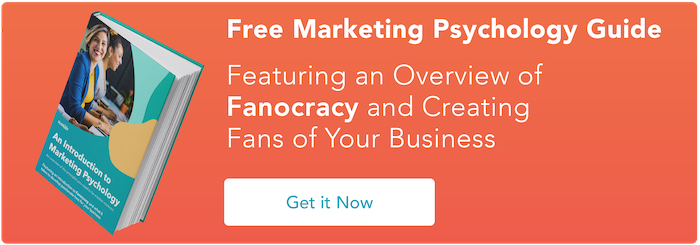Users, visitors, prospects, leads, and customers.

What do all these words have in common?
They’re how we, as marketers, classify the people who engage with our brand -- humans with needs and desires. Yet, as we lump them together in analytics dashboards, based on view time, country of origin, bounce rate, and countless other attributes, it’s easy to forget that they’re just like you and me.
Human needs and desires create demand for your business. They’re what your product or service aims to fulfill. But, in order to fulfill these needs and desires, your business needs more than just a good product. You also need a solid grasp of design.
Design, more than anything else, is understanding what drives people’s behavior. What do they want? How do they want to receive it? And how can you deliver it to them? In other words, you need a firm grasp of psychology.
Fortunately, when you optimize your website design for conversion, you can leverage psychology everywhere: in colors and numbers, shapes and taglines, and even the serifs of letters. And knowing how psychology and design intersect is key to guiding prospects toward conversion.
Below, we’ll take a look at four foundational principles that will help you marry psychology with design, as well as some little-known phenomena that can give you an edge in your design and conversion rate optimization efforts.
How to Convert With Psychology: 4 Design Levers To Pull
1. Beat the curse of knowledge.
From the moment you set out to design any form of marketing collateral -- an ad, email, or landing page -- you’re cursed. Cursed with knowledge, that is.
To explain further, you obviously know your product well. Your audience, however, does not. So, even if you’ve created a new and innovative product, its benefits won’t register with your audience if you can’t explain it in simple terms. This phenomena isn’t limited to new and complicated products, either. A lot of times, simpler products require the simplest descriptions.
Take bed sheets, for example. Bed sheets are an ubiquitous product that everyone knows how to use. We don’t need to read a manual to understand how to stretch them over our mattresses.
All bed sheets aren’t created equal, though. For instance, you could sell bed sheets with microfibers, high thread counts, or distinct material types. And when you're writing descriptions of your bed sheets’ features and benefits, it’s natural to think everyone else has the same knowledge about microfibers and thread counts as you do.
What you may not realize, however, is that most of your target audience won’t have your level of product expertise. Consequently, in your attempt to convey a unique selling proposition, you could’ve filled your product description with jargon, which actually makes its selling point harder to understand.
This is the reason the curse of knowledge is so hard to beat -- even if you know it’s impacting your ability to write clear, concise, and compelling copy, you can’t really pinpoint the curse’s degree of affect on you. Try all you want, but it’s almost impossible to truly imagine what it’s like to be in your prospects’ shoes. You can’t "unknow” what you know.
So, how do you beat the curse of knowledge?
Consider testing your ad, product listing, email, or landing page on members of your target audience who haven’t been exposed to your product yet.
During your test, try to figure out if they can immediately understand why your product is better than your competition. If they can’t, ask them to explain why, and use their feedback to optimize your marketing collateral in the future.
2. Channel your inner city planner.
Nowadays, attracting attention is a huge challenge and retaining it is even harder. But, in order to convince a visitor to convert on your website, you must be able to do both.
To help you attract and retain your target audience’s attention, let’s go over some findings from a branch of social science founded in the early 1900s -- Gestalt Psychology.
Most people are familiar with Gestalt psychology through the phrase, “The whole is greater than the sum of its parts,”, which, today, can be translated to “Rather than perceiving all things equally, we perceive them in the context of their whole.”
For example, image you’re driving through a bustling city. When you’re behind the wheel, what are you paying attention to? Most likely your surroundings, like the cars around you, lights, signs, pedestrians, and bikers, right?
Well, that’s not because there’s nothing else to pay attention to. There’s much more to pay attention to in a busy city. Your brain is just focusing your attention on the most relevant stimuli in your specific situation, like other drivers, pedestrians, and signals, instead of irrelevant stimuli, like restaurants and barber shops (unless you’re looking to grab a bite to eat or get a haircut).
Now, this isn’t happening just because of your amazing prioritization skills. It’s also happening because most cities are designed relatively well. For instance, one way signs show you which streets you can’t turn on, yellow lights warn you to slow down, and red octagons tell you to stop. These indicators have been reinforced as important signals in your mind ever since you started driving.
In regard to digital marketing, a similar process takes place when visitors consume a web page. Our visitors are like drivers in a city, and as marketers and designers, we need to effectively guide them toward the most important parts of our web pages. To learn how to do this, check out the following principles from Gestalt psychology:
The Law of Similarity
Humans tend to group similar things together. Due to this tendency, we also notice things that stand out from the crowd. For example, in the image below, clustering the yellow flowers around the red one makes it stand out.
When it comes to guiding visitors toward certain elements of your web page, the law of similarity is the most important principle to leverage. Any contrast in size, motion, color, and weight will attract people's attention.
Eye tracking studies also show that we “enter” web pages through its largest elements, like its image or headline. Then, we consume the smaller elements, like its subheadings, bullets, bolded and italicized words, and then finally its copy.
In a nutshell, if an element is larger than its surroundings, like a headline or featured image, it will draw more attention than its surroundings. If an element is a different color than its surroundings, like a call-to-action button or a form, it will also draw more attention than its surroundings. And if elements look different, like bolded or italicized words, they will draw more attention than the text around them. These are some principles to keep in mind when you’re designing content for consumers who have a fleeting amount of attention.
The Law of Past Experience
The Law of Past Experience states that visual stimuli, under certain circumstances, will be categorized according to past experiences. For instance, consider the standard website design. The internet has been around long enough that certain designs have become so common that they’re an industry standard now.
Navigation bars will always be at the top of websites. Site links will be at the bottom. And since humans have been reading for such a long time, a headline will lead to a subheading, which will then lead to body copy. Breaking this fundamental structure by aligning your text to the right or moving your navigation bar to the left sidebar will only create confusion.
The Law of Pragnanz
Our brains prefer simplicity. Whenever possible, we will simplify complex visuals to comprehend them in an easier, quicker fashion. So don’t over-complicate your web pages. Unless you’re writing for industry insiders, eliminate jargon from all your content. You should also stray away from huge blocks of text. If you need to write longer body copy, separate it into digestible chunks of information, like small paragraphs or bullet points.
The Law of Proximity
When perceiving a group of visual stimuli, we group things that are close together. For example, below, you see two groups of dots, one set of 18 and another set of 12, as opposed to one set of 30 dots.
So whether you’re labeling form fields or creating icons with descriptive text, your visitors should instantly understand what belongs where.
3. Leverage the decoy effect.
If your landing page features two pricing options, and your goal is to subtly guide visitors to choose one option over the other, consider including a third, decoy option, which is an asymmetrically valued option that taps into our natural desire to get the best deal possible.
One of the most well-known examples of the decoy effect comes from a famous pricing experiment conducted by Dan Ariely, a behavioral economics professor at MIT.
In his study, he asked 100 MIT students which of the following subscriptions they’d rather purchase.
The print-only subscription was the decoy option, since it was the same price as the print & web subscription but offered significantly less value. After he took his poll, he discovered that 84% of the participants selected the print & web subscription, 16% of them selected the web-only subscription, and none selected the print-only subscription.
According to these results, The Economist would have generated $11,444 in revenue from these students.
In another poll given to 100 different students at MIT, Ariely removed the “print only” option and asked them which subscription they would rather purchase. This time, the results were the complete opposite of the first experiment -- a measly 32% of the participants chose the print & web subscription and a whopping 68% of them chose the web-only subscription.
Without the decoy option, which made the most expensive option seem like a better deal, significantly less people bought the priciest subscription and significantly more people bought the cheapest subscription.
According to these results, The Economist would’ve only generated $8,012 in revenue from these students, which was nearly $3,500 less than the experiment with the decoy option.
In sum, to successfully use the decoy effect, you have to make sure that your third option is asymmetrical in value to the other two options. Put simply, the decoy should make the option you want to nudge your visitors toward look like the best deal.
In the experiment above, most participants choose the print & web subscription because they thought they were getting something that was worth $185 for only $125. But, if you think about it, is the print-only subscription really worth $125? Most likely not.
When the print & web subscription was priced this way, though, the participants thought they were buying a print subscription and getting a free web subscription. As a result, they perceived this subscription to be the best deal and couldn’t help but choose it.
4. Minimize user stress as much as possible.
Imagine you’re trying to register for an account on a popular discussion forum so you can post a pressing question. However, there’s an issue with your form.
You’ve hit “Register” twice already, but the page has reloaded with an error message at the top of the form that says “Sorry, there was a problem with your registration. Please make sure all fields are accurate.” This form is also fifteen fields long, and there’s no indication of what you’ve exactly done wrong.
Needless to say, you’re frustrated. And this stress greatly impacts your biology, triggering the release of the stress-inducing hormone, cortisol. In a blog post for ConversionXL, Alex Birkett elaborates on cortisol’s effect on your target audience:
When users feel frustrated, they get stressed and cortisol starts to build up. If it hits a certain threshold, users will give up and go to your competitor’s site. Life is too short to go crazy trying to deal with crappy form design as well as unhelpful error handling.
Most of us can relate to this kind of experience -- attempting to solve a problem once or twice and then giving up and going somewhere else.
This is an unforgivable way to lose conversions. Think about it -- these visitors want to convert. In fact, they’re so eager to convert that they’re trying to do so a second time. But, unfortunately, you weren’t clear about the error they made. So they left to find another website that didn’t make converting so hard.
To combat this issue, you should write descriptive error messages next to the field where the error was made. And make sure these messages don’t just say “Error”. They should describe the exact steps the user must take to correct the problem.
An even better thing you can do is to clearly label each form field. This will decrease the likelihood of user error because, sometimes, designers overestimate their user’s ability to remember things.
For instance, imagine you’ve arrived at a form that has placeholder text inside each field, like, “Enter age here” and “Enter email address here”. You begin to fill it out, and once you’re four out of six fields through, one of your co-workers walks up to your desk.
A few minutes of small talk later, you return to the form. But you're having trouble recalling the information you’re supposed to enter in the current field. Even though you just have to delete the text in the field, it still frustrates you, triggering the release of cortisol in your brain.
Brands need to consider this small yet potent problem when building their forms. And according to Katie Sherwin of Nielsen Norman Group, it’s especially important they do so because of how distracted people are today.
If the user forgets the hint, which people often do while filling out long forms, he has to delete what he wrote and, in some cases, click away from the field to reveal the placeholder text again. In an ideal world, users would be entirely focused when filling out a form. But in reality, users multitask. They have different tabs open, or they might be pulled away by an email or phone call. For complex tasks, they might have to stop and go retrieve a document or order number. From our research on mobile usability, we know that mobile users are also frequently distracted and interrupted while using their devices. So, it’s important to help users pick up where they left off.
The best way to help users pick up where they left off is by placing clear, permanent labels above or next to each field, like this:
And for those wanting to remove nearly all friction from form completion, consider a one-click sign-up through Google or Facebook.
Converting With Psychology
The list above is just a few examples of the countless psychological phenomena that impact user behavior. When you better understand how the human brain operates, you can apply some proven principles in all aspects of web design to win conversions.
Now the only question is, will you?



![11 Website Page Load Time Statistics [+ How to Increase Conversion Rate]](https://blog.hubspot.com/hubfs/page-load-stats.webp)







![Lead Conversion: Everything You Need to Know [+ Expert Tips]](https://blog.hubspot.com/hubfs/Lead%20Conversion.png)